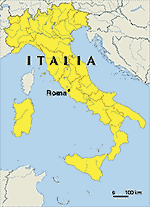Benvenuto! – Information About Italy
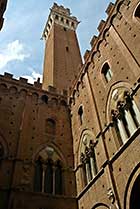 Let's begin the journey to Italy with useful information and interesting facts about the country, presented below.
Let's begin the journey to Italy with useful information and interesting facts about the country, presented below.
- why travel to Italy
- history of Italy
- general information
- Italian AC power outlet/plug
- consular information
- health and safety
- travel to and through Italy
- currency and costs
- climate and weather
- how to dress
- when to go to Italy?
- holiday conditions
- accommodation
- people and language
Interesting facts about Italian customs, Italian food, wine and restaurants describes the next page.
Italy, officially Italian Republic (Italian: Italia or Repubblica Italiana)
Italy as a country has existed since 1861. Until then, even though the area was culturally coherent, since the collapse of the Roman Empire it was divided into many republics, states, kingdoms and duchies.
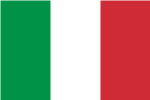
Flag of Italy
Italy is located in Southern Europe, mainly on the specifically boot-shaped Apennine Peninsula. The outline of the Italian Republic is determined by mountains – the Alps on the north and by the seas around the peninsula: the Mediterranean, Ligurian, Tyrrhenian, Ionian and Adriatic. In addition Italy occupies several neighboring islands, among them the largest islands in the Mediterranean - Sicily and Sardinia.
Two very small countries are located within the Italian borders, and they are legally separated from the Italian Republic – Vatican City and Republic of San Marino.
The place seem to be separated from Europe, yet with such a huge impact on the continent. Italy with all the legacy of the Roman Empire has left a strong mark on cultural, scientific, legal development of Europe and western civilization.
Ancient culture so sophisticated, and yet so cruel. A society based on slavery, praising the games full of cruelty, bloodshed and death. After the great conquests of the empire, it was broken and divided politically for centuries. Finally Italy has been reunited with difficulty, but still is full of friction.
Why Travel To Italy?
Because this country has something special... It's associated with the sun, hot air, noise of cicadas, good food, good wine, tranquility, but also with the tradition and history.
An excellent illustration of the point is the comparison of France and Italy. Both countries have specific regions that are worth seeing, respectively Provence and Tuscany – really interesting places.
In France you will face a situation where the guidebook is full of information about this or that place – that it is old, it's important for the country's history etc. When you go there, you often see some old ruins, probably old, but to praise them so much...?
In Italy, the opposite is true. They do not have to promote their sights. The country is steeped in history. When you go through Tuscany, you see many picturesque villages that look as if the past centuries have not made any impression on them. Italians do not need to prove anything... What you see, defends itself.
You must see Provence, but you want to go back to Tuscany...
The History Of Italy In A Nutshell
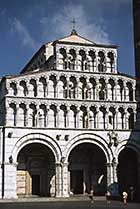 The history of Italy after the heyday of the Roman Empire was full of divisions, fights, takeovers and feuds. Surprisingly the country which was fairly consistent culturally, was so divided politically.
The history of Italy after the heyday of the Roman Empire was full of divisions, fights, takeovers and feuds. Surprisingly the country which was fairly consistent culturally, was so divided politically.
The area of today's Italy was in ancient times inhabited by various ethnic groups and tribes. Simplifying the point a bit, the north was populated by the Ligurians, Celts and Veneti, the central part by the Etruscans, Umbrians and the Latins (the Romans derive from them), the south by the Greeks. These people were then conquered and Latinized by the Romans. Interestingly the Latins were a relatively small tribe, but one of their cities became the driving force of a great empire.
According to the legend of Romulus and Remus, Rome was founded in 753 BC, on April 21. From the sixth century BC the Roman Republic began conquering and uniting peninsula around Rome. It became a center of the Roman Empire in the first century BC.
During the next centuries this area experienced ups and downs. Ascent time in the heyday of the Empire and weakness after its fall. The break-up of the Empire into the Eastern and Western parts in 395 AD and the Visigoths, Vandals and Huns raiding the Western Roman Empire created a difficult time for Italy. This led finally to the collapse of the Western Roman Empire in 476. The strengthening of the political power of the Popes, raids of the Ostrogoths and the Lombards have made the divisions on the peninsula even worse.
For the next almost 14 centuries Italy was the scene of successive wars, conquests, the creation and the fall of kingdoms and more or less independent duchies. Parts of the land were under the reign of several important European dynasties. The political divisions illustrates the political map of Italy from the end of the fifteenth century.
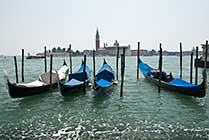 Political friction between the secular power and the Pope and the lack of a dominant center of power has created fertile ground for the emergence of city-states (Genoa, Milan, Pavia, Modena, Cremona, Florence, Siena, Venice). They were economically and culturally vibrant centers, many of which have survived the centuries, examples are the trade powers - Genoa and Venice, and one of the major cultural centers - Florence (especially under the rule of the Medici family). They were also the cradle of the Renaissance and a fifteenth-century Italy was the scientific and cultural center of Europe.
Political friction between the secular power and the Pope and the lack of a dominant center of power has created fertile ground for the emergence of city-states (Genoa, Milan, Pavia, Modena, Cremona, Florence, Siena, Venice). They were economically and culturally vibrant centers, many of which have survived the centuries, examples are the trade powers - Genoa and Venice, and one of the major cultural centers - Florence (especially under the rule of the Medici family). They were also the cradle of the Renaissance and a fifteenth-century Italy was the scientific and cultural center of Europe.
Various rulers at different times tried to unite Italia, but without success. Only in the 1st half of the nineteenth century unification ideas have grown in popularity in Italian society, creating a foundation for the Risorgimento movement, but it failed as well. Finally on March 17 1861, on the part of the current Italian lands the Italian Kingdom was proclaimed ruled by king Victor Emmanuel II. One by one other parts of Italy were annexed until 1870, when the unification process came to an end by inclusion of Rome and Lazio. In 1871 the capital of the young Kingdom moved from Florence to Rome.
The next years were the time of building the administrative, legal, educational, economic growth. Northern Italy was well developed, industrialized, in contrast to the poor, agricultural south. Unfortunately this division did not disappear till the present day.
Italy in various configurations has been involved in various armed conflicts, especially in World Wars I and II. A referendum carried on June 2, 1946 decided to abolish the monarchy in Italy and establish the republic. The final shape of the borders was established in 1954, when Italy signed an agreement with Yugoslavia, dividing the Free Territory of Trieste.
General Information About Italy
- Currency: Euro, code: EUR, sign: €
- The electric network is the standard European one (230V, 50Hz). However there is an issue with local AC power outlets (see below)...
- Local time: Central European Time zone - CET, which is UTC +1 (Summer Time UTC +2). In Rome it's the same time as in Paris or Berlin.
- Telephone country code: +39
- Country code top-level domain used by websites: .it
Italian AC Power Outlet/Plug
Italy is one of the few EU countries that does not officially apply CENELEC standards. Although recently, especially in renovated houses, you will be able to find more often the European electrical outlets as well – after all, tourism is an important business in Italy.
Usually you will find there specific Italian outlets (Type L, CEI 23-16/VII) with 3 holes in a row, with a protective-earth connection in the middle. There are two types: the low power 10 A and the higher power 16 A.
Generally, the small two-pin Europlug, with thinner pins (CEE 7/16 standard) fits in the local Italian lower power outlets. A larger European plug, with thicker pins (CEE 7/17, or CEE 7/7) will fit only in the European outlets. Anyway, the UK and US plugs will not fit.
The following pictures would help, visualizing the point:

Types of European AC power plugs, Euro plug CEE 7/16 fits into the Italian outlet type L - 10 A.
Beneath you see the Italian universal electrical outlet with a switch (left connector 10 A, 16 A on the right):
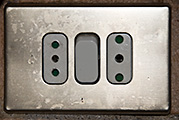
Summing up, do not experiment, because this may end up badly, you'd better have with you a proper adapter - a universal AC power outlet converter.
Consular Information
The Italian Republic is a member of the European Union and the Schengen Agreement. Citizens of Schengen countries may stay in Italy up to 90 days, without special permission. Travel document to be entitled to visa-free entry and residence (regardless of its purpose) is a passport or identity card. Non-Schengen travelers (so also from UK) should have valid passports. UK and US citizens do not need a visa entering Italy up to 90 days for tourist or business purposes.
Word of caution: buying counterfeit goods of world famous brands from the street sellers is forbidden and may be penalized by incurring large fine - the buyer is punished! So you have to be careful, especially since this trade is fairly common in major Italian cities...
The completion of declaration of presence is required if you come from Schengen countries and if, for example, you arrive by plane from US the stamp in your passport at the airport is the equivalent. This obligation is usually processed by the Italian national inviting a foreigner or by the hotel staff.
Before leaving for Italy no vaccinations are required. It is usually wise to buy travel and medical insurance before travelling.
Check also your Ministry of Foreign Affairs website regarding Italy, as an example information about Italy from the UK Foreign & Commonwealth Office site and US Department of State site.
Health And Safety
 We've never found dangerous animals in Italy, like snakes or scorpions. Only once a small lizard visited our apartment through the chimney hole in the kitchen. But it just made some noise on the metal hood, and then escaped.
We've never found dangerous animals in Italy, like snakes or scorpions. Only once a small lizard visited our apartment through the chimney hole in the kitchen. But it just made some noise on the metal hood, and then escaped.
You may encounter there stormy weather. We survived pretty strong storms. The first one happened happily during our stay in the holiday apartment. Heavy rain started in the evening and was falling through the night, the wind blew furiously, tossing a big tree standing beside our house. The next day was quiet. It was August. In August, especially in the second half the weather becomes more rainy and the temperature slowly decreases. It was indeed a special summer, because shortly after our departure from Italy, a flood affected this country...
The second storm caught us in July. We traveled by car through southern Tuscany, and suddenly black clouds covered the sky. When hail began to pound loudly on the roof of the car, we ran to the nearest gas station under the shelter. The hail was so big and loud that I was afraid of severe car damage. Fortunately the car was not harmed, but this storm stayed in memory.
To protect our skin against the strong Italian sun we apply a cream – sunscreen with UV filter.
Bathing in the sea is safer when we put on swimming shoes, especially helpful on rocky beaches.
The Southern Apennines are tectonically unstable, the volcanic areas (Vesuvius, Etna) contribute to earthquakes.
One more issue. We take with us for the longer trips some basic medicines that we know and usually use – against a cold, fever (also a thermometer), diarrhea, and eventually allergies. The last one is essential if you are allergic. We never forget of course about the medicines required for long-term treatment. We also pack some other basic medical supplies, like bandages, sticking plasters, something for decontamination, such as alcohol, and besides UV sunscreen, also after-sun creams for sunburns, because sometimes a sunbath proves to be too effective... Be careful with perfumes when sunbathing, as occasionally they may cause some skin allergy.
Unfortunately, this equipment has been useful a couple of times. Our own medication lets us avoid a discussion with the pharmacist in a foreign language, and it is worth remembering that the local medicaments often have different names than in our home country. In addition, the local drug leaflets written in the local language will be hard to understand if you do not speak that language.
Of course, all this is related to the simple situations, when according to our experience we are able to apply basic medicines. In more complex cases we are going to a doctor.
Travel To And Through Italy
You can easily fly to Italy by plane. The largest airport is in Rome, but there are alternatives as well. Tuscany and Veneto has several airports. In Tuscany, Florence is the largest, but there are also flights to Pisa. In northern Italy the Veneto region has a major airports in Venice and Verona. In Lombardy, there is also a major international airport in Milan - Malpensa, Italy's second largest.
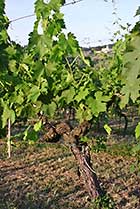 Another option – for travelers from Europe – is going to Italy by car. If you drive long distances with children on board, a portable DVD player or mobile device like a tablet might be of great help. Recently such equipment became cheaper. Children are busy watching movies and do not have time to think "How far it still is".
Another option – for travelers from Europe – is going to Italy by car. If you drive long distances with children on board, a portable DVD player or mobile device like a tablet might be of great help. Recently such equipment became cheaper. Children are busy watching movies and do not have time to think "How far it still is".
Northern Italy has natural border – the Alps. Hence there are not too many options, which way you can drive to Italy. From the west side there are some highway connections from France and Switzerland. From the north actually the main way leads through Austria and Brenner pass to the A22 Italian highway. From the east there are roads from Austria and Slovenia then highway A4 directing to Venice.
If someone goes skiing in the Italian mountains, for example in the Dolomites, the Brenner pass and then the A22 highway might be the best way to go.
In general, use caution on Italian roads, because there are people who drive dangerously, with Italian fantasy. They are changing lanes without a sign, they are passionately cutting curves on the local narrow and winding roads, etc. This does not apply to everyone, but the phenomenon is noticeable.
Highways in Italy are paid. It means for us not too many crossroads with local road infrastructure, as it reduces the number of tollgates.
Restricted access zones are often organized in city centers, particularly historic ones in a number of Italian cities. They are called ZTL (Zona a Traffico Limitato). The reason is the narrowness of the streets, huge traffic and the fight against air pollution. You cannot go there by car without permission. Seeing the ZTL signs, leave the car outside the area. Driving in without a pass you risk fines, as the areas are controlled with telecameras. Everybody wants to have nice pictures from holidays, but nobody wants to pay for them so much...
Fuel purchase at a gas station
In Italy, unleaded gasoline is called senza piombo, and diesel is gasolio. Automated, self-service stations, although cheaper, are not easy to operate for foreigners. The process of payment in automatic system is described in Italian, which is a nightmare for the foreign driver. It is better to use the normal stations, with human service, where after refueling you can simply pay the personnel by card or cash.
The inscription Chiuso on the plate in front of the station means that it is closed, and Aperto that it is open. The inscription Aperto 24 Ore means that it is open 24 hours. It does not mean that there is human service all that time. If it is located outside the highway, most likely it is a self-service at night.
Word of warning – you should be aware that prices of gasoline might be different on the same station according to the pump you use. The outer ones are for self refueling the car, therefore are cheaper. The pumps closer to the building sometimes are part of a "full service area" – the personnel refuels the car there, so the gasoline is a bit more expensive. You pay extra for clean hands. In both cases you pay the same way – the guy at paydesk inside the building. So watch the signs and information about prices.
Drivers please remember:
- it is obligatory to drive with headlights turned-on throughout the day outside urban areas and in tunnels,
- possession of reflective vests is compulsory and it has to be put on when in an emergency situation the driver or the passenger leaves the car,
- it is forbidden to use cell phones while driving without a hands-free set,
- blood alcohol content shall not exceed 0.5 ‰.
Just as curiosity - Italian police can fine not only for speeding, but also for too slow driving on the highway, as it may cause disruption in traffic...
Currency And Costs
Italy is part of the Eurozone, so the currency is the Euro (EUR), and the sign is €.
Credit cards (especially VISA and MasterCard) are widely accepted in Italy, as in the whole Europe. Important note for Americans. In many countries in Europe credit cards with a stripe and authorized by signature are replaced by chip cards with a pin code. So it's worth to remember the pin to your credit card.
Financial issues are quite complicated and unstable in recent years, so please treat this information just as indication of the market trends.
Please check the useful official Italian highways operator website (in English), where you can plan your journey. Unfortunately the names of departure and arrival cities should be written in Italian. It will calculate the route, displaying distance, travel time, toll, also showing weather, fuel prices on sample stations along the way etc.
Example tolls of Italian highways:
Milano (Milan)-Firenze (Florence) 286 km / 177 mi – €19.90
Brennero (Brenner Pass)-Roma (Rome) 715 km / 444.5 mi – €48
Torino (Turin)-Venezia (Venice) 399 km / 247 mi – €29.70
Fuel in Italy is quite expensive in comparison with other European countries.
Costs of living in Italy fit in the Eurozone average, being on the higher side because of the taxes. For a UK tourist Italy might be cheaper, for travelers from US Italy will be more expensive (quite often the price would has the same amount as in the States but in euro instead of dollars...).
The costs depend on the preferences. You can stay in a luxury hotel, or in an apartment rented in a village for example in Tuscany, where agritourism (agriturismo) is becoming popular. You can eat very well in small cheap trattoria, but also you can spend a lot in a main street restaurant. You can buy food and beverages in a downtown shop, or go to a supermarket. The prices will differ considerably.
Important note - many museums or historical sites (including the cathedrals, and churches) charge for admission. Instead of paying more, buying separately the ticket for each site, it's worth buying the city card with unlimited (or nearly unlimited) access to many sites and museums throughout the city. Examples: Verona Card, or Venice Card. It's a much cheaper alternative.
Climate And Weather In Italy
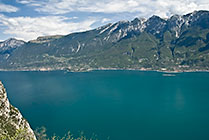 The climate is quite varied and depends on the particular location. Apart from the high mountains, where it is usually more "extreme", on the peninsula, in its northern part (the valleys of river Po and Adige, alongside the line Turin – Venice) the climate is continental, humid, with relatively cold winters and warm summers.
The climate is quite varied and depends on the particular location. Apart from the high mountains, where it is usually more "extreme", on the peninsula, in its northern part (the valleys of river Po and Adige, alongside the line Turin – Venice) the climate is continental, humid, with relatively cold winters and warm summers.
Coastal areas (except the north-eastern part) are characterized by a Mediterranean climate with relatively warm winters and warm summers (in the south even hot). Wet is mainly during winter, summer is dry. In addition the higher and further inland the place is located, the colder it is.
The coldest month is January with an average temperature of 0°C/32°F in the valley of the Po, to 12°C/53°F in Cagliari. Snow falls not only in the mountains, but also falls during the winter in the northern and central Italy. The warmest month in the north is July (32-35°C/89-95°F) and in the south is August (38-42°C/100-109°F).
More to the north August becomes a bit more rainy and stormy than July. So if you go to Tuscany and Veneto, you better do it in July than in August.
Our friend from Italy, who lives near Lake Garda claims that "at the end of August, the winter is coming, as he must wear a sweater"... Actually it's not so bad, but the fact is that the weather is changing. Once when we were in Veneto in August we faced a lot of rainy moments, and it wasn't too hot. Our August in Tuscany was also more rainy than July. Of course the annual variation in weather conditions plays an important role here as everywhere, but it is worth considering this information.
By the way, regarding the weather forecasts, during one stay when we were in the vicinity of Venice, we examined the forecasts for Venice published by the Tourist Information Office. The report was prepared in several languages, probably downloaded from the Internet from different countries — their national meteorological offices. There were forecasts in Dutch, German, English (from UK) etc. Interestingly, for some days those forecasts were completely different, if not opposite. I do not know what kind of weather models those meteorological offices use, but probably some of them are not too accurate...
Therefore, you may want to review the Italian website with information about the weather, it should be more accurate... It is in Italian, but the symbols and figures are understandable. In addition to the current weather (oggi – today, domani – tomorrow) you will find there the forecast for 6 days and also, if necessary, for another week (prossima settimana). You can check also more detailed information about the weather for regions, cities, mountains, airports, etc.
How To Dress
In Italy the summer is generally warm, but in addition to typical summer clothes you should have a sweater for colder nights and a raincoat for bad weather.
If you walk a lot, you might want to take comfortable sports shoes, and swimming shoes to bathe in the sea, as some shores are rocky ones.
If you spend a lot of time outdoors on sunny days, it is worth to remember about sunglasses. They will protect your eyes from strong light.
And one more issue related to the outfit. In Italy, visiting churches in short pants or a short skirt and a shirt or a dress without sleeves is unwelcome. When you plan to visit religious sites, wear something with short sleeves, even a t-shirt and take care of trousers or skirts below the knee. In particular, it is worth remembering when going to the Vatican.
When To Go To Italy?
That's a pretty basic question. Generally, nice weather allows tourists to feel comfortable in Italy from May till September. The main season is related to the European vacations, which are usually in July-August timeframe. For those who are not tied up with this official vacation time, it may mean an opportunity to have cheaper holidays in May or June, also it might be important for some that the temperatures are a bit lower at that time than in July (it's not so hot).
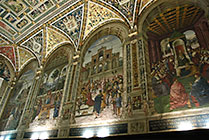 If the main season time is the only possibility, then given the weather conditions, it is better to go to Tuscany or Veneto in July. Another important factor is that the August is the peak vacation season in many European countries. In August Italians, French and several other nations are going on summer holidays. That means a lot more traffic on the roads. During the weekends, especially at the beginning of August, when everyone is leaving, there is a huge traffic jam on highways.
If the main season time is the only possibility, then given the weather conditions, it is better to go to Tuscany or Veneto in July. Another important factor is that the August is the peak vacation season in many European countries. In August Italians, French and several other nations are going on summer holidays. That means a lot more traffic on the roads. During the weekends, especially at the beginning of August, when everyone is leaving, there is a huge traffic jam on highways.
In addition, what might look a bit strange, even the Italian restaurateurs then go on vacation. In the period when they could have more customers, as the fellow citizens have vacations, they close the business. Not every restaurant is closed of course, but seeing "closed" signs several times, we were surprised.
If you're going on a vacation organized by a travel agent, this information is of less importance. Arriving by plane, the meals planned for in advance reduce the troubles. However, if you prefer to travel "independently", driving a car, eating on your own at local restaurants, then you might want to consider those circumstances.
If you go skiing in the winter in the Italian mountains, try to avoid the week when the carnival ends. This time is variable, depending on Easter. This week, Germany and some other countries in southern Europe have holidays.
Holiday Conditions In Italy
For Italians, tourism is a very important branch of the economy. Tourists are willing to come here, and their number reaches 44 million annually, placing Italy in 5th place of the world's most popular holiday destinations.
This translates into a decent tourist infrastructure and not only a great number of accommodations of varying standards, but also a huge number of restaurants of all types.
The last point, to some extent relates also to the Italians' lifestyle. They like to eat outside and that has a positive impact on quality and price. Restaurateurs do not focus only on the tourists (well, maybe except for places like Venice), they have to keep high quality of food and good prices to not deter their regular clientele...
Accommodation
In Italy you can find accommodation in many hotels and camping sites. Another popular option is the rental of vacation apartments. Italians rebuild old houses, farm buildings near the homes into holiday facilities. Most of them are decorated in the local style. The buildings old looking outside, inside are refreshed and well equipped, especially the kitchen. The interior is kept in the style of the building, usually is equipped with old, stylish furniture. The restoration of old cabinets, dressers, tables, etc. is largely in fashion in Italy right now.
Owners often build swimming pools for their guests, which is especially relevant in places located far from the sea, for example in the heart of Tuscany.
The house usually has two or more apartments, sometimes there is only one. Once we got to the apartment in a large estate, where we were alone and shared the swimming pool and spacious surroundings only with the hosts, incidentally, very likeable, who appeared rarely. Outside, under the shelter there was a big table where we would eat Italian dinner in the open air...
Many of the apartment buildings are prepared in the country or outside the cities. A major advantage of this solution is peace and silence. You can live the pace of the local community. This means also that the grocery is usually a bit faraway and you need to take the car to the nearest village, but the inconvenience is actually a rewarding opportunity to observe the beauty of the surrounding vineyards and olive groves.
People And Language
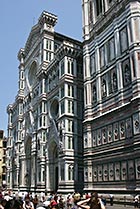 Italians are generally very friendly people, with a very expressive nature. Sometimes it seems that they shout at each other, actually they just talk so loud... They are open, helpful, they try to communicate with the tourists. The knowledge of English among older people is rather weak. However, the ability to speak English among the younger generation is pretty good.
Italians are generally very friendly people, with a very expressive nature. Sometimes it seems that they shout at each other, actually they just talk so loud... They are open, helpful, they try to communicate with the tourists. The knowledge of English among older people is rather weak. However, the ability to speak English among the younger generation is pretty good.
The South Tyrol, which is in the Trentino-South Tyrol region (Trentino-Alto Adige / Südtirol) is practically bilingual. Most people in addition to the Italian are fluent in German.
Regarding the Italian language, in terms of vocabulary it is closest to Latin of all the Romance languages. Groundwork for the modern Italian placed great poet and writer Dante Alighieri. Writing the Divine Comedy in 14th century, he used his Tuscan dialect, so it became the basis for the official language of Italy.
Speaking of Romance languages, once I was sitting at the table with my friends - one Italian and one Spaniard. At one moment they turned from English into their languages. The Italian, spoke Italian to the Spaniard, and he answered him in Spanish. And so the dialogue was going on... When I expressed my surprise, they explained that their languages are very similar and they are easily able to understand each other and communicate this way...
